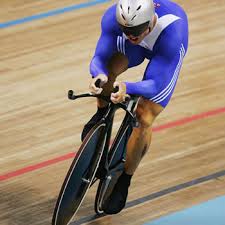 OK, so you agree to do a 5 minute time trial....but how do you pace it for the best performance? Particularly how do you start off? Fast then slow down, slow then speed up or just try to keep it even.....
OK, so you agree to do a 5 minute time trial....but how do you pace it for the best performance? Particularly how do you start off? Fast then slow down, slow then speed up or just try to keep it even.....5 minutes is a really difficult distance - like the mile in a run: not a sprint but not a long slow thing either.
This study says it is better to go off fast.....
Effects of starting strategy on 5-min cycling time-trial performance.
The importance of pacing for middle-distance performance is well recognized, yet previous research has produced equivocal results. Twenty-six trained male cyclists (VO(2peak) 62.8 +/- 5.9 ml . kg(-1) . min(-1); maximal aerobic power output 340 +/- 43 W; mean +/- s) performed three cycling time-trials where the total external work (102.7 +/- 13.7 kJ) for each trial was identical to the best of two 5-min habituation trials. Markers of aerobic and anaerobic metabolism were assessed in 12 participants. Power output during the first quarter of the time-trials was fixed to control external mechanical work done (25.7 +/- 3.4 kJ) and induce fast-, even-, and slow-starting strategies (60, 75, and 90 s, respectively). Finishing times for the fast-start time-trial (4:53 +/- 0:11 min:s) were shorter than for the even-start (5:04 +/- 0:11 min:s; 95% CI = 5 to 18 s, effect size = 0.65, P < 0.001) and slow-start time-trial (5:09 +/- 0:11 min:s; 95% CI = 7 to 24 s, effect size = 1.00, P < 0.001). Mean VO(2) during the fast-start trials (4.31 +/- 0.51 litres . min(-1)) was 0.18 +/- 0.19 litres . min(-1) (95% CI = 0.07 to 0.30 litres . min(-1), effect size = 0.94, P = 0.003) higher than the even- and 0.18 +/- 0.20 litres . min(-1) (95% CI = 0.5 to 0.30 litres . min(-1), effect size = 0.86, P = 0.007) higher than the slow-start time-trial. Oxygen deficit was greatest during the first quarter of the fast-start trial but was lower than the even- and slow-start trials during the second quarter of the trial. Blood lactate and pH were similar between the three trials. In conclusion, performance during a 5-min cycling time-trial was improved with the adoption of a fast- rather than an even- or slow-starting strategy.

4 comments:
I recall a fair number of comments during this year's Tour de France about starting strong and letting the pace level off naturally.
Seems fairly obvious, the body responds to stress. You apply a stress, it adapts. In something like the five-minute distance, you have to apply the stress as early as possible.
Heh, but if you look at time splits for riders winning the 4km (pursuit) race at the Olympics/Worlds/etc., the start (approx first half lap or 15 secs on a 250m track) is done at about 90% of maximum, then they settle down into a pace which is more or less even, sometimes slightly slower over the closing laps.
Most important is the second half of the first lap, overcook it and the rider almost always falls apart in the closing kilometer.
In a nutshell, get up to speed quick (so using CP stores), then follow a fairly even "schedule".
(which works on a velodrome due to the lap nature, as opposed to a point to point road course)
We discussed this at the USATF cert. I went to back in June. It deals with energy systems. The phosphagenic and glycolytic systems get depleted whether you use them to their fullest potential or not, which is why you're best to rocket off the line, then settle into your pace in the 800-3000m races. The same probably holds for 5k and 10k too...if you don't use it, you will lose it regardless.
Cheers
Scott Kustes
Fitness Spotlight
Post a Comment